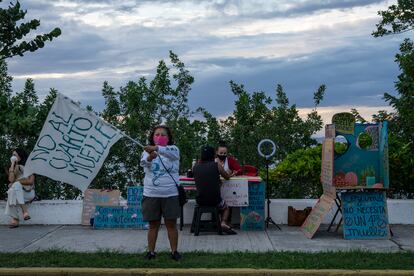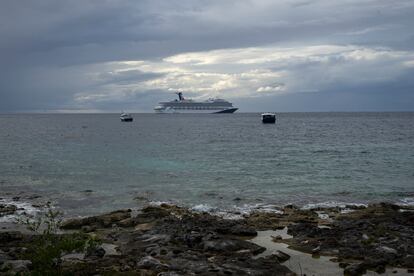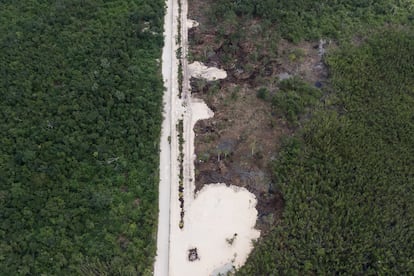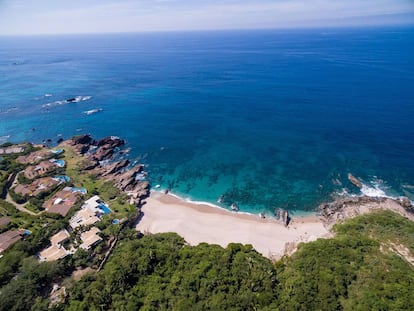Cozumel, the Mexican island taking a stand against cruise ships
Environmentalists are waging a legal battle against the construction of a fourth enormous pier on a UNESCO Biosphere Reserve where coral reefs could be destroyed

The sound of someone breathing underwater is like a hypnotic purr. Every breath produces a long column of bubbles rising to the surface and a sound like Darth Vader’s mask. The man behind this mask is the biologist Germán Méndez, who advances in a perfect horizontal line, his oxygen tank strapped to his back, as though supported by an invisible harness. He is diving in the crystalline waters of the Caribbean, carefully looking after his coral farm. If one is lying on the sea bed, he gently replaces it so that it does not fall down again. Some look like purple tentacles, others resemble yellow brains or huge folding fans swaying in the sea. “What do you think of my office?” he asks as he emerges.
But Méndez’s office, off the island of Cozumel on Mexico’s eastern seaboard, is under threat. In an area that has been reserved for the preservation of coral for a decade, the government has authorized the construction of an 800-meter (2624-foot) mass of concrete: the island’s fourth international cruise ship pier. The project is part of a strategic plan set out by President Andrés Manuel López Obrador in October 2020 to kick-start the economy after the ravages of the coronavirus pandemic. Méndez, on the other hand, believes that destroying part of the coral reefs the island is famous for is akin to “shooting the golden goose.” And he wonders aloud: “What are tourists going to come for? To see dead rocks? Cozumel isn’t an island of piers, it’s a coral island.”
When the sun starts to set, the stretch of the coast where the pier will be built starts to fill up. A group of friends drink cans of beer under a mangrove and a little further along a couple kiss with the sound of the sea in the background. The area is so close to downtown Cozumel that it is a popular place for residents to while away the afternoons. Here there is no dollar charge to enter nightclubs like there is in the tourist areas. There are no frozen margaritas or umbrella-shaped straws. Here there is just a public space, of which there are fewer and fewer, where those who do not have a lot can feel wealthy admiring the turquoise sea as the sun tints the horizon red. When the pier goes up, this part of the beach will be off limits to the public.

A group of women arrive in a whirl of noise to collect signatures calling for a public consultation on the project. The youngest, Olivia Rose, whizzes up and down the promenade on her scooter with a flag bearing the name of the collective: “No to the fourth pier.” Environmentalist Guadalupe Martín Cab, who is also president of the Conservation, Research and Environmental Management of Cozumel (Cimac) organization, applauds Rose’s efforts while she sets up a small table on the sidewalk. Claudia Yaneth Cifuentes, a staunch supporter of López Obrador, asks a man who wants to sign up for the cause for his ID. The collective is heterogeneous, as is the fight against a project that aims to bring more tourists to an island where livelihoods depend on tourism.
Martín Cab knows what she wants to say and she wants to say it quickly, before darkness falls. “The question is: why do they want to build a fourth pier when the ones that are already there are never full?” She has the numbers to prove it, too. Cozumel has three international cruise ship piers that did not exceed 54% of their capacity in 2018 or 2019, buoyant years for tourism before the pandemic hit. Even so, Cozumel is one of the most-visited islands in the world by cruise ship operators. The company that won the contract, Muelles del Caribe, gained a juicy bit of business. As well as constructing the pier, it will also put up a terminal building with a commercial area attached. And there could lie the answer to Martín Cab’s question: in a statement, the company said “evidently, the pier is being built for future operations and not current ones, and as such is needs to have greater dimensions than those currently in operation.”
When Martín Cab found out about the project, Cimac carried out a census of the zone that counted around 20 different species of coral, among them two that are on the endangered list. However, when Muelles del Caribe presented their own findings to the environmental authorities the company reported only seven species. That led Martín Cab to join forces with Méndez and other organizations on the island to file an injunction against the project, with the help of the Mexican Center for Environmental Law (CEMDA). The action was admitted by the courts in January. In early February, a second injunction filed by the “No to the fourth pier” group was also accepted by a federal judge, who ordered the project provisionally put on hold while the matter is deliberated in court.

It is Monday morning and as soon as dawn breaks these floating cities begin to appear in the sea. There are five of them, which translates into thousands of people who will descend on the beaches early and reboard their cruise ships to set sail again around 5pm. Taxi drivers wait for fares in a huge line, but the majority of the day-trippers have their itineraries set by their tour operators. They descend to the terminal building, board buses and head for beach clubs or an ATV tour of the jungle. They will use all use the bathroom, it is estimated, at least twice during the day. Meanwhile, the island’s one sewage treatment plant works at full tilt. If the fourth pier is built, there could be up to 18,000 more daily visitors arriving on Cozumel, a UNESCO Biosphere Reserve.
The viewpoint of the institutions that promote tourism at a national level is more flattering. Marisol Vanegas, who served as secretary for tourism in the state of Quintana Roo until last July, is a supporter of the fourth pier because in her estimation it will not only increase the number of visiting ships but will also diversity the types of company that arrive on Cozumel. Vanegas points out that every cruise ship tourist spends around $175 (€153), which is “not inconsiderable given they are only there for a few hours.” However, she acknowledges that visitors who stay in hotels to dive around the island spend more.
A cruise ship operated by Disney sounds its horn, which emulates a famous jingle from the cartoons of our childhoods. It also interrupts Miriam Moreno, who is wondering who genuinely benefits from this kind of tourism. “These are huge corporations who feed off other huge corporations. What trickles down to residents is really very little.” A social psychologist and diver, Moreno is a member of the Coral Hero organization, which is dedicated to the community conservation of reefs in various parts of Quintana Roo. She says that since 2020, when cruise ships largely stopped coming because of the pandemic, the island’s economy has supported itself through its main source of employment: the diving industry. “But if it continues to be managed as it is now, the reefs are not going to last much longer. And divers tend to look for living areas, not dead ones.”

What is happening in Cozumel is also happening elsewhere in the world. Venice’s decision to stop welcoming cruise ships reverberated globally. To what extent can a place entertain so many people on a daily basis, provide them with fresh water and deal with their waste? How many cruise ships can anchor at an island before its viable limits are breached? In environmental terms, Cozumel’s beauty is also a curse. Tens of thousands of tourists want to enjoy its coral reefs, its beaches and crystalline waters, and its forests that contain dozens of unique species. But to meet that demand it is necessary to build beach clubs, resorts and controversial projects like Lakam-Ha, in the south of the island, which gradually eat away at the pristine landscapes that attract tourists in the first place. This has been the story of Cancún, Playa del Carmen and Tulum in Mexico’s Caribbean coast.
“What they are doing across the whole of the Riviera Maya is cutting down mangroves, building hotels and pumping sewage into the sea. That is why we are seeing huge amounts of algae in those areas, which are killing off the coral,” says marine biologist Thomas Goreau, president of the Global Coral Reef Alliance. Goreau worked alongside Méndez in the reef restoration project in Cozumel and says that the nutrients contained in sewage provide food for algae, but are lethal for coral. To this has been added so-called White Syndrome or White band disease, a coral disease that was first detected in Florida in 2014. Four years later it had killed off half of the reefs around Cozumel.
Méndez appears uncomfortable on dry land. He is happier in a wetsuit, propelling himself forward with long blue fins, tending to what he calls “his coral,” as though they were his offspring. Around him, he sees only destruction where others see economic development. When the interview ends, he asks with a concerned look: “Did I sound too catastrophic?”
Tu suscripción se está usando en otro dispositivo
¿Quieres añadir otro usuario a tu suscripción?
Si continúas leyendo en este dispositivo, no se podrá leer en el otro.
FlechaTu suscripción se está usando en otro dispositivo y solo puedes acceder a EL PAÍS desde un dispositivo a la vez.
Si quieres compartir tu cuenta, cambia tu suscripción a la modalidad Premium, así podrás añadir otro usuario. Cada uno accederá con su propia cuenta de email, lo que os permitirá personalizar vuestra experiencia en EL PAÍS.
¿Tienes una suscripción de empresa? Accede aquí para contratar más cuentas.
En el caso de no saber quién está usando tu cuenta, te recomendamos cambiar tu contraseña aquí.
Si decides continuar compartiendo tu cuenta, este mensaje se mostrará en tu dispositivo y en el de la otra persona que está usando tu cuenta de forma indefinida, afectando a tu experiencia de lectura. Puedes consultar aquí los términos y condiciones de la suscripción digital.
More information
Últimas noticias
Petro claims the ELN was the target of US attack in Venezuela
Maduro counterattacks Trump with rhetoric and announces downing of nine drug trafficking aircraft
‘Ecce Homo’: The miraculous disaster that made a small Spanish town famous
Return to sex testing at the Olympics: IOC edges closer to banning transgender women
Most viewed
- Sinaloa Cartel war is taking its toll on Los Chapitos
- Oona Chaplin: ‘I told James Cameron that I was living in a treehouse and starting a permaculture project with a friend’
- Reinhard Genzel, Nobel laureate in physics: ‘One-minute videos will never give you the truth’
- Why the price of coffee has skyrocketed: from Brazilian plantations to specialty coffee houses
- Silver prices are going crazy: This is what’s fueling the rally











































